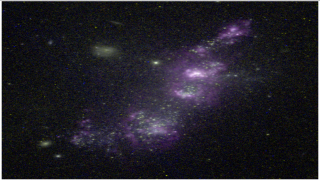Bibcode
Arribas, S.; Colina, L.; Alonso-Herrero, A.; Rosales-Ortega, F. F.; Monreal-Ibero, A.; García-Marín, M.; García-Burillo, S.; Rodríguez-Zaurin, J.
Referencia bibliográfica
Astronomy and Astrophysics, Volume 541, id.A20
Fecha de publicación:
5
2012
Revista
Número de citas
32
Número de citas referidas
31
Descripción
Aims: We study the analogy between local luminous and
ultraluminous infrared galaxies (U/LIRGs) and high-z massive star
forming galaxies (SFGs) by comparing their basic Hα structural
characteristics, such as size and luminosity surface density, in an
homogeneous way (i.e. same tracer, size definition, and similar physical
scales). Methods: We use integral field spectroscopy (IFS) based
Hα emission maps for a representative sample of 54 local U/LIRGs
(66 galaxies) observed with INTEGRAL/WHT and VIMOS/VLT. From this
initial sample, we select 26 objects with similar Hα luminosities
(L(Hα)) to those of massive (i.e. M⋆ ~
1010 M&sun; or larger) SFGs at z ~ 2, and observed
on similar physical scales. We then directly compare the sizes, and
luminosity (and SFR) surface densities of these local and high-z
samples. Results: The size of the Hα emitting region in the
local U/LIRGs that we study has a wide range of values, with
r1/2(Hα) from 0.2 kpc to 7 kpc. However, about
two-thirds of local U/LIRGs with Lir > 1011.4
L&sun; have compact Hα emission (i.e. r1/2
< 2 kpc). The comparison sample of local U/LIRGs also contains a
larger fraction (59%) of objects with compact Hα emission than the
high-z sample (25%). This gives further support to the idea that for
this luminosity range the size of the star forming region is a
distinctive factor when comparing local and distant galaxies of similar
SFRs. However, when using Hα as a tracer for both local and high-z
samples, the differences are smaller than those reported using a variety
of other tracers. In the L(Hα) - L(Hα) surface density
(ΣHα) plane, most of the local U/LIRGs and high-z
SF galaxies follow the same trend (i.e. higher luminosity for higher
surface density) and cover a similar range, except for about 20-40% of
local U/LIRGs, which have a higher ΣHα by a
factor of about 10. This is considerably smaller than the factors of
1000 or more reported in similar planes (i.e. L(TIR) versus
ΣTIR). Despite of the higher fraction of galaxies with
compact Hα emission, a sizable group (about one-third) of local
U/LIRGs are large (i.e. r1/2 > 2 kpc). These are systems
that show evidence of pre-coalescence merger activity and are
indistinguishable from the massive high-z SFGs galaxies in terms of
their Hα sizes, and luminosity and SFR surface densities.
Proyectos relacionados

Grupo de Estudios de Formación Estelar GEFE
El proyecto interno GEFE está enmarcado en el proyecto coordinado, ESTALLIDOS, financiado por el plan nacional desde el año 2001. El ultimo proyecto aprobado es ESTALLIDOS 6.0 (AYA2016- 79724-C4-2-P). En el proyecto GEFE trabajamos en base al caso científico del proyecto ESTALLIDOS 6.0. Los estallidos de formación estelar (Starbursts o SB) son
Casiana
Muñoz Tuñón